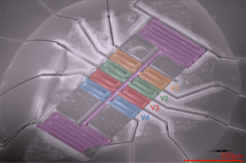Press Release: Electron rivers
Although one might think that when there is an electric current in a metal, the electrons flow like water would in a pipe, that is actually not the case. Their motion is impeded because they bounce off the atoms that make up the metallic crystal, and the flow process is not nearly as interesting as the ones that we can see at play any time we sit next to a river. For ‘electron rivers’ to exist, one needs to find extraordinary materials in which the collisions with the host atoms are thousands of times weaker than usual. Although this possibility, known as ‘electronic hydrodynamics’, was predicted theoretically over fifty years ago, it has taken until now to reach the new regime in a bulk material. In Science Magazine (volume 351, 4th March 2016; see also the article "Perspectives" by J. Zaanen), three papers simultaneously reported experimental success. The groups of Philip Kim at Harvard and Andre Geim at Manchester worked on graphene, but the contribution from the Mackenzie and Moll groups from this Institute (Max Planck Institute for Chemical Physics of Solids Dresden) was based on an oxide metal.
Our material of choice, PdCoO2, has an astonishingly high electrical conductivity, making it possible to look for hydrodynamic effects. To reveal their presence, we sculpted successively narrower channels, and studied how easily the electrons could flow through them. By combining our results with a special theory that is able to model hydrodynamic effects, we were able to show that we had indeed created the long-predicted electron rivers. The research opens new frontiers in research into electron behavior in ultra-pure materials. The richness seen in the flow of water might be observable in the flow of electrons, and some of this richness might one day also lead to the invention of new electronic devices. We hope to play a leading role in these developments.

One of the “electron rivers” that we created for our research. The flow takes place along the purple channel, and is studied using instruments attached to the blue, red, green and gold-coloured parts of the device. The channel width is about one fifth of the diameter of a human hair.
AM / CPfS
